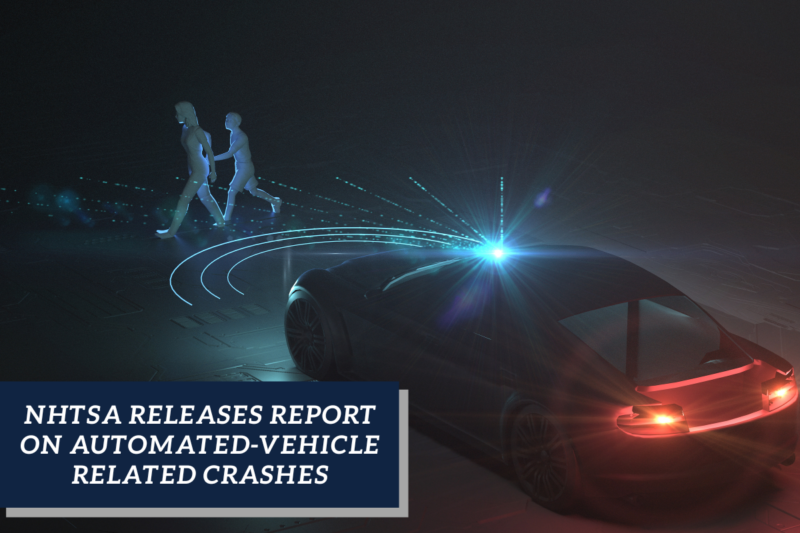
According to a new report released by the National Highway Traffic Safety Administration (NHTSA), vehicles with automated driving systems have been linked to a number of recent collisions. Tragically, a small portion of those crashes turned out to be fatal.
Manufacturers and operators of vehicles with SAE Level 2 ADAS (advanced driver assistance systems) are required to report accidents to the NHTSA, per new regulations that were approved in 2021 (SAE stands for the Society of Automotive Engineers). The NHTSA has gathered data on multiple types of “self-driving” cars, including cars with ADAS and fully automated vehicles.
ADAS vehicles require human interaction, and motorists must remain alert at all times in case they need to take over from the automated system. Mostly and fully autonomous vehicles typically don’t require as much (if any) human input as ADAS vehicles.
According to the agency’s report, 392 ADAS vehicles were involved in crashes from July 2021 to May 15, 2022. In total, the crashes resulted in six fatalities and five seriously injured individuals. Interestingly, of the 392 vehicles that were involved in accidents, 273 were manufactured by Tesla. 90 of the autonomous vehicles involved in collisions were manufactured by Honda, and 10 were manufactured by Subaru.
Asignificant portion of the vehicles Tesla manufactures feature self-driving capabilities, which may be why most of the crashes involved vehicles manufactured by that company. According to TechCrunch, there are approximately 830,000 Tesla vehicles with Autopilot features currently on the road, making it the largest manufacturer of autonomous cars. One of the next largest autonomous vehicle manufacturers is Nissan, with 560,000 self-driving Nissans currently on U.S. roads.
The NHTSA has also been tracking SAE Level 3-5 automated vehicles, and you can view the data they have collected in this separate report. Per the NHTSA, there were 130 crashes involving ADS (automatic driving systems) reported to the agency from July 13, 2021 to May 15, 2022. “Vulnerable road users” were involved in 11 of the 130 collisions. Vulnerable road users include pedestrians, bikers, and others.
Further analysis will be needed to understand the data that has been reported. While it is difficult to draw specific conclusions regarding Tesla Autopilot or other automated driving systems solely based on the data referenced in the report, one thing is clear. In the NHTSA’s words, “No commercially available motor vehicles today are capable of driving themselves.”
One of the main issues with automated and driver assistance features is that they give motorists a false sense of security when they are behind the wheel. Most autonomous vehicles still require driver input, and when drivers get distracted by certain activities and fail to pay attention, they may not notice when their vehicle’s automated system is asking the driver to take control of the car. Driver distraction can lead to serious collisions, devastating injuries, and catastrophic property damage.
SAE Levels of Automation
The levels of driving automation range from zero to five. You can read more about each level on the SAE website. We will briefly review each level below:
- Level 0 – Level 0 vehicles require the motorist to maintain control of the vehicle at all times, even if they aren’t operating the pedals or the steering wheel. Level 0 automation features are restricted to warning signals and automatic emergency braking.
- Level 1 – Drivers must constantly maintain control of vehicles with Level 1 driving automation. Level 1 vehicles feature support systems for steering, braking, and accelerating, but the motorist must remain vigilant and be prepared to retake control of the car if necessary.
- Level 2 – Level 2 automation systems provide similar but slightly more advanced steering, braking, and acceleration support to drivers, who are in control of the vehicle 100% of the time.
- Level 3 – Level 3 driving automation does not require a motorist to drive while the automated system is engaged. However, if the automated system instructs the driver to take over, they must be prepared to do so at any time.
- Level 4 – Level 4 automated systems do not require the motorist to take over at any time as long as certain conditions are met. Vehicles with Level 4 driving automation are not considered “fully automated.”
- Level 5 – Vehicles with Level 5 automation are “fully automated” and do not require motorists to take over the vehicle at any time while the system is engaged. Level 5 automation is designed to work under any conditions.
Fully automated vehicles are not currently available for consumers to purchase and drive. The vast majority of “self-driving” vehicles on the market today still require driver input, meaning motorists must remain vigilant while their vehicle is in motion.
What to Do If You Are Hit by an Autonomous Vehicle
If you are injured in an accident that was caused by an autonomous vehicle, you might be wondering whether the driver is still liable for your medical expenses and other losses. Thankfully, because nearly all vehicles with driving automation systems still require driver interaction, you should be able to pursue compensation from the motorist who was responsible for the accident.
While the vehicle manufacturer could potentially be liable if the accident occurred because of a defective part or system, the operator is still obligated to prevent accidents by staying alert, avoiding distractions, and being prepared to take over driving when necessary.
Unfortunately, driving automation features may cause motorists to become complacent behind the wheel. They may engage in negligent behaviors like distracted driving, drunk or intoxicated driving, or driving while fatigued because they feel impervious. But if a motorist hits you while using automated features, you still have a legal right to hold the driver accountable for your financial and non-financial losses.
Contact a Georgia Autonomous Car Accident Lawyer
If you were injured in an accident that was caused by a driver in an ADAS or ADS vehicle, contact the Duluth self-driving car accident attorneys at Brauns Law Accident Injury Lawyers, PC today. Call us at 404-418-8244 for a free, no-risk consultation to discuss your case and evaluate your legal options.














